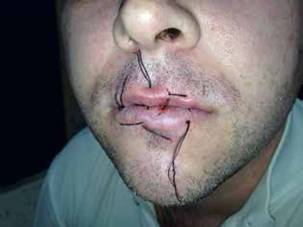As Sancho Panza said to the noble gentleman, in the first part of Chapter XXV of Don Quixote “...to go seeking adventures all one's life and get nothing but kicks and blanketings, brickbats and punches, and with all this to have to sew up one's mouth without daring to say what is in one's heart, just as if one were dumb."
In this section of Prison Healthcare in images we would like to illustrate graphically some curious images that we have come across in our every day practice.
Among the measures of protest that inmates take in prison to show their discomfort before what can be considered unfair, or as a measure of pressure to achieve some type of benefit or change, or just as a means of standing out we have seen a wide variety of self-inflicted injuries: sharp wounds1, stabbing of metallic objects in the abdominal wall2 or elsewhere3, intake of toxic substances such as bleach4; or foreign bodies5 (blades, batteries, needles, etc.).
Nevertheless if there is a means of protest that has further become a true opposition struggle is that of voluntary fasting or “hunger strike”, which entails a series of ethical, deontological and legal controversies within the correctional setting, both for the administration and for healthcare providers. Its incidence rate was estimated at 11.09 episodes per every 1000 inmates and year and a multi-centre study on 22 Spanish prisons6 revealed that the most common fasting period was that of between two and seven days (40.6%) followed by that of only one day (27.2%) and only lasting for more that fourteen days in 12.2% of cases.
Hunger strike can be carried out in different ways: solid (refusal to take in food but able to drink), dry (when no food or liquids are taken) and its most extreme version, by sewing one’s lips in an attempt to show how serious the commitment is.
These stitches are usually done by means of sewing needles and thread or strings with no concern for asepsis whatsoever. They usually involve the con tinuous stitch of both lips trying to seal completely the mouth (Figure 1) or by sewing only the central part of the mouth (Figure 2), which allows drinking and even smoking - a deep-rooted habit among inmates.
















